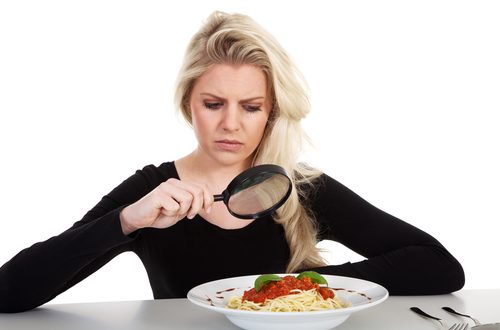Let’s face it. Some foods are just difficult to eat. Your career and personal life may call for you to dine with management, vendors, guests, family, people in your own community, and possibly even with global visitors. The food served at both business and social occasions may not be food that you would normally choose to eat.
What follows is a list of many foods that can be a challenge and how to easily eat those foods without embarrassment. If you forget exactly what comes next when dining out, take a deep breath and watch your host. Follow his or her lead.
- Artichokes: The leaves are removed one at a time with your fingers. Dip the soft end of the leaf in the sauce that is provided. Pull the leaf through your teeth to eat the edible part. Place the inedible part of the leaf on the side of your plate. You may scrape the center part (called the thistle or heart) with your knife and fork. Cut the heart into manageable pieces and eat these pieces with a fork.
- Bacon: Eat very crisp bacon with your fingers. Otherwise, bacon is eaten with a knife and fork.
- Baked Potatoes: Make a small cut in the top of the baked potato (if this was not done in the kitchen) and lightly squeeze the potato open with one hand. Using your dinner fork, take some butter from your bread plate. Place the butter in the potato. Eat the inside of the baked potato first, American style, using a fork. Eat the skin with a knife and a fork. You may wish to eat the inside of the potato Continental style, using both a knife and a fork.
- Berries: Eat berries with a spoon. If strawberries are large and served with the stem still on, you may hold them by the stem and eat them in one or two neat bites. Large strawberries are served with sugar for dipping.
- Caviar: Caviar comes from the roe, or eggs, of a fish called a sturgeon. Caviar is served in a small crystal bowl that is set on a surface of well cracked ice. To the side of the caviar are either small, round pieces of toast or little Russian pancakes (blinis). Spoon a small amount of caviar onto your toast or blini and add a drop of sour cream, chopped egg and/or capers onto the caviar. This gourmet treat is eaten with the fingers.
- Corn on the Cob: Save this vegetable for casual meals. Butter and season several sections at a time. Never butter the entire ear; that’s just plain sloppy. Grasp the ear of corn securely in your hands and eat the sections you have buttered and seasoned. Butter and season the next section.
- French Fries: French fries are cut in half and eaten with a fork. The exception to this rule is when the fries are served with a sandwich. Then they become finger food. All bets are off at fast food emporiums and drivethroughs (also called drivethrus). French fries, served with openfaced sandwiches are eaten with a knife and fork.
- Fried Chicken and Other Birds: All birds may be eaten with a knife and fork. Small game birds may be taken apart with a knife and fork and eaten with the fingers of one hand. Fried chicken is generally eaten in public with a knife and fork. Fried chicken is properly eaten with the fingers at picnics, fast food establishments and in the family kitchen.
- Frogs’ Legs: Frogs’ legs are held and eaten with the fingers of one hand. The legs are first disjointed with a fork and knife. Frogs’ legs taste very much like chicken. The meat is white and tender.
- Garnishes: A garnish is a vegetable, fruit, or flower that is used to decorate the dinner plate. If these are edible, they may be eaten with a fork. Do not pick up garnishes with your fingers.
- Lobster: Separate the larger parts of the lobster with your hands. Pull off the claws. Crack the claws with a nutcracker. Extract the tender meat with a cocktail fork. Or ask your server to have the lobster separated and cracked in the kitchen. Lobster is traditionally dipped in either melted butter or cocktail sauce. Never order a lobster at a business meal if you are the guest or at an interview if you are being interviewed. It is both a messy and inappropriately expensive choice.
- Nuts: Casually, nuts are eaten with the fingers. Informally, there may be no spoon in a dish of nuts. If there is a spoon, use the spoon to pick up the nuts and place them directly from the spoon onto your cocktail plate or cocktail napkin.
- Olives, Radishes, and Other Relishes: Olives, radishes, pickles, baby carrots, and celery are eaten with your fingers. These finger foods are called relishes. If there is no serving fork, you may take the relishes from their tray with your fingers. At a meal, place them directly on your dinner plate. As cocktail party food, place them on a paper napkin or on a cocktail plate.
- Oysters, Clams and Mussels: Use a cocktail (or oyster) fork for oysters, small steamed clams on the halfshell and mussels. Using your cocktail fork, dip these delicacies in the sauce or butter provided. Eat in one bite. If served on toothpicks, eat from the toothpick. Mussels served on the halfshell may be picked up with your fingers and sucked directly from the shell. Large raw clams on the halfshell are eaten with a seafood fork or the fingers. The rubbery neck sheath that cannot be eaten may be pulled off with the fingers. Go ahead and dip and eat this large raw clam with your fingers. Place discarded shells in a separate bowl and dip the clams in broth or melted butter. When you have finished eating the clams, you may drink the broth using a spoon (or drink the broth directly from the bowl). Fried clams are eaten with a fork.
- Sandwiches: Openfaced sandwiches are cut and eaten with both a knife and a fork. French fries served with openfaced sandwiches are also eaten with a knife and fork. Eat small teatype sandwiches with your fingers. Cut club sandwiches with a fork and knife into quarter portions and pick up these smaller portions with your hands. The traditional sandwich that Mom made and is found on any casual restaurant menu is eaten with your hands.
- Sauces: Sauces are either poured directly onto or just next to the meat, fish or chicken on your dinner plate. Never drown your meal with sauce.
- Soft and Hard Shell Crabs: Soft shell crabs are cut with both a knife and fork and eaten with the fork. The entire soft shell crab is eaten, legs, shells, everything! Hard shell crabs require that you pull away the larger pieces by hand and then pull off the claws. Eat only the meat in the claws of the hard shell crab. You may need a nutcracker to crack the claws. Extract the tender meat from the claws with a cocktail fork.
- Spaghetti: This is a form of pasta. Pasta is a doughy noodle made in a variety of shapes. Spaghetti is long and thin. Pick up two or three strands with your fork and place the prongs of the fork against the side of your plate. Twirl the strands against the side of your plate until they are gathered onto your fork. Suck them quietly into your mouth. Do not use a spoon. Northern Italians will frown on the peasant-like technique of using a spoon for assistance. Most pastas are eaten with a fork. Ravioli is eaten with a spoon. Never order spaghetti or other pastas at an interview meal.
- Snails: With one hand, hold the snail shell with the tongs that are provided. With your other hand, use the oyster or cocktail fork provided to pull out and eat the snail. If there are no tongs, use your fingers to secure the shell. Using your other hand, pull out and eat the snail with the oyster or cocktail fork provided. If bread is served, it may properly be dipped into the garlic butter in which the snails sit.
- Watermelon: Casually, at a picnic or barbeque, watermelon is eaten holding a cool, crisp slice in your hands. Otherwise, eat sliced watermelon with a fork. If it is served already cubed, eat it with a spoon. You will have to drop the seeds from your mouth directly into your hand and then place the seeds onto your plate.
People will notice both your professional and personal behavior, especially at the table. Follow these simple guidelines and you will always appear polished and competent in business and social manners.
Excerpts of blog may have been taken from the book: Hospitality Management – People Skills & Manners on and off the Job. Copyright © 2015 Lyn Pont, Ph.D.
“Pont’s book is a must-read for anyone considering a career in hospitality.”
— Isadore Sharp, chairman and founder, Four Seasons Hotels and Resorts
See the book at: www.HospitalityManners.com
Visit Lyn at: www.MannersForBusiness.com
#hospitality #dining #etiquette #manners #business




